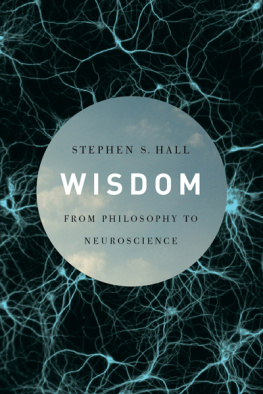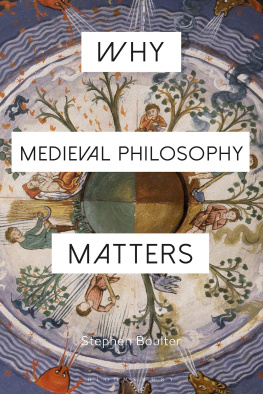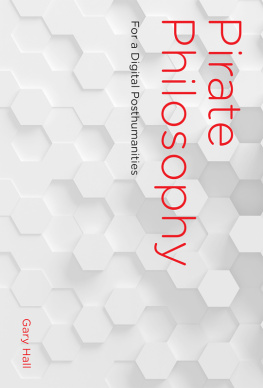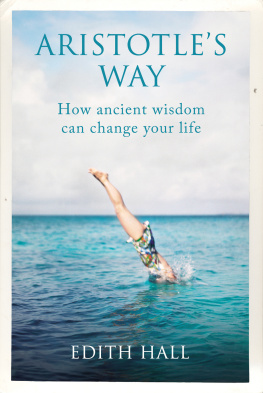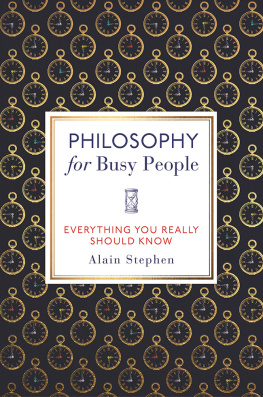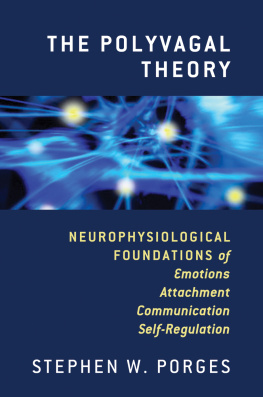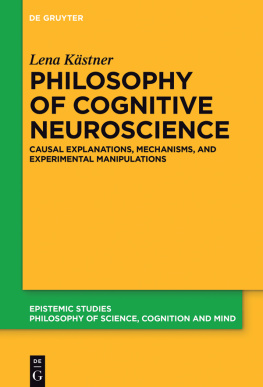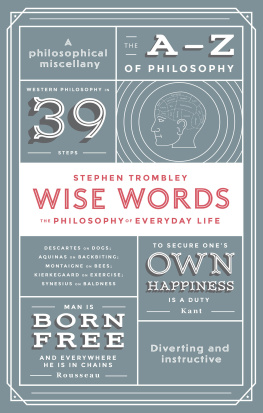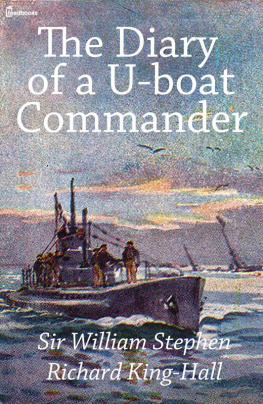Stephen S. Hall - Wisdom: From Philosophy to Neuroscience
Here you can read online Stephen S. Hall - Wisdom: From Philosophy to Neuroscience full text of the book (entire story) in english for free. Download pdf and epub, get meaning, cover and reviews about this ebook. year: 2010, publisher: Alfred A. Knopf, genre: Politics. Description of the work, (preface) as well as reviews are available. Best literature library LitArk.com created for fans of good reading and offers a wide selection of genres:
Romance novel
Science fiction
Adventure
Detective
Science
History
Home and family
Prose
Art
Politics
Computer
Non-fiction
Religion
Business
Children
Humor
Choose a favorite category and find really read worthwhile books. Enjoy immersion in the world of imagination, feel the emotions of the characters or learn something new for yourself, make an fascinating discovery.
- Book:Wisdom: From Philosophy to Neuroscience
- Author:
- Publisher:Alfred A. Knopf
- Genre:
- Year:2010
- Rating:5 / 5
- Favourites:Add to favourites
- Your mark:
- 100
- 1
- 2
- 3
- 4
- 5
Wisdom: From Philosophy to Neuroscience: summary, description and annotation
We offer to read an annotation, description, summary or preface (depends on what the author of the book "Wisdom: From Philosophy to Neuroscience" wrote himself). If you haven't found the necessary information about the book — write in the comments, we will try to find it.
Stephen S. Hall: author's other books
Who wrote Wisdom: From Philosophy to Neuroscience? Find out the surname, the name of the author of the book and a list of all author's works by series.
Wisdom: From Philosophy to Neuroscience — read online for free the complete book (whole text) full work
Below is the text of the book, divided by pages. System saving the place of the last page read, allows you to conveniently read the book "Wisdom: From Philosophy to Neuroscience" online for free, without having to search again every time where you left off. Put a bookmark, and you can go to the page where you finished reading at any time.
Font size:
Interval:
Bookmark:
As Confucius once said, The superior man is sparing in words. But any author would gladly risk Confucian wrath when it comes to acknowledging all the invisible hands that help nurture a book into print.
First, a quick disclaimer as a form of thanks. Anyone who presumes to tackle as weighty a subject as wisdom is asking for cosmic comeuppanceeither from the large, discriminating circle of general readers who collectively know more about this rich subject than any one writer can hope to master, or from the smaller (and possibly less forgiving) circle of friends and loved ones who might reasonably wish to have seen a bit more wisdom from the author on a daily basis. To both constituencies, I express gratitude in advance for their understanding of errors, omissions, and inconsistencies. Wisdomthe binding of the current volume notwithstandingis always a work in progress.
Ive always wanted to write a book about neuroscience; I just never expected this to be the one. I attribute this unexpected turn of events to several neuroscientists who primed me for this task even though they had nothing to do with steering me in the direction of wisdom (and, quite possibly, might distance themselves from my final destination). So let me first thank my four neuro-Virgils, who have over the course of two decades guided my way through the increasingly thick forest of brain science.
I first interviewed Eric Kandel of Columbia University in 1985. This is another way of saying that not only was I introduced to the biology of memory more than twenty years ago but have been schooled for many years to think of this quintessential human quality as an everyday process that converts our experiences into neurological changes at the molecular level. In 1997, I was privileged to describe to readers of The New York Times Magazine this world of neural proteins and activated genes in the creation of memory (Manipulating Memory); the notion of neural plasticity is essential to any modern ideas about wisdom.
In 1998, while working on another story for the Times magazine (The Anatomy of Fear), I received an advanced tutorial on the biology of fear from Joseph LeDoux of New York University, who has been a modern Magellan circumnavigating every node of the emotional part of the brain. Since then, Joe has been a constant and generous source of information, edification, and, not infrequently, correction. Again, at the level of molecules and neural wiring, I was fortunate to be exposed early on to the powerful idea that emotions unconsciously guide many of our thoughts and actions, and Joe has been an exemplary source in conveying that message.
With the advent of functional magnetic resonance imaging (fMRI), my journalism about neuroscience became more participatory, and I was again lucky to entrust my brain to several leading figures in the field. As part of that same story on the biology of fear, I underwent my first journalistic MRI brain scan in the summer of 1998, as a participant in a fear experiment conducted by Elizabeth Phelps, then at Yale University. You could say I passed with flying colors, in the sense that the mere anticipation of receiving a shock made my amygdala (which we science writers often describe as the center of fear) explode like fireworks designed by the Grucci brothers. Liz, who has since moved to NYU, has consistently lived on the leading edge of social neuroscience; her most recent work shows that our brains can be trained to optimize cognitive performance in a variety of challenging circumstanceshopeful news for anyone interested in wisdom.
Finally, in 1999, I had the good fortune to concoct, with neuroscientist Joy Hirsch, then at Memorial Sloan-Kettering Cancer Center, a series of custom-designed fMRI experiments on my brain that appeared in a special millennium issue of The New York Times Magazine (Journey to the Center of My Brain). Experiments is in quotes because, when you study a single brain, you have no grounds to claim any scientific validity. Nonetheless, we did some interesting neural reconnoitering and, I would like to think, broke some conceptual ground that anticipated later experiments that have appeared in the literature. We looked at my brain when it was doing ordinary daily tasksreacting to cartoons (to explore the human sense of humor), gazing at a photograph of a loved one, and listening to the voices of ones children (to explore the neural basis of emotional memories).
We also wanted to see what was happening under the hood when I was doing the kind of thing I presumably do well, which is to use language and tell stories. So Joy, who now heads the Program for Imaging and Cognitive Sciences at Columbia University, put me in the scanner and then asked me to perform more creative tasks: to make up a story on the fly while viewing a random set of images, to concoct sentences suggested by several pictures, and to invent similes. The MRI images didnt show anything as focused and dramatic as the center of metaphor or the storytelling node of the brain. But the sheer symphonic sprawl of activation, like those vast lattices of lightning bolts that sometimes spread synaptically across the Western sky, was both thrilling and humbling. Theres a lot going on in there, even when were looking at a Gary Larson cartoon.
I didnt realize it at the time, but it seems to me now that there was a hugely important lesson about wisdomand neurosciencein that diffuse sprawl of neural activity. Our modern explorers of the brain are still, like the explorers and cartographers of the sixteenth century, pinning down its fundamental geography. But the actionin wisdom and probably in most other higher-order human thoughtis in those neural circuits and connections that are just now coming into focus, not to say the dynamic changes in connective strength in that circuitry that is audited and revised on a daily basis. Ive been very fortunate to learn these lessons from masters in the field, and it has been an honor to pass their knowledge along to the general public.
Along with my four neuro-Virgils, I must in the same Florentine spirit thank my estimable patrons at The New York Times Magazine for supporting my serial explorations of neuroscientific issues; over the past decade, Ive been lucky to have as editors Adam Moss, Jack Rosenthal, Gerald Marzorati, Katherine Bouton, Stephen Dubner, Michael Pollan, and Vera Titunik. Several years ago, more specifically, I received an incredible gift from the magazine when Vera asked me to look into an article about wisdom research for a special issue devoted to baby boomers, which sparked my initial interest in the topic. In addition to Vera, who edited the original piece, I am grateful to Robert Wallace, who did some of the initial conceptual spadework for the story; Jim Schachter, who curated the entire issue; and Eric Nash, who backstopped my accuracy.
If part of wisdom is the ability to keep old friends while gaining new ones, Iand this bookhave been triply blessed. When I first met Wallace Matson in 1990, on the lawn of Villa Serbelloni in Bellagio, Italy, he confided, Croquet is my game. I momentarily wondered what kind of person would dare boast about such an arcane skill; he turned out to be a superb classicist and twentieth-century philosopher. From his wonderful translation of Epictetus to his excellent history of philosophy to his sage advice on matters philosophical, Wallace has been immensely helpful (and indulgent) as I stumbled over his turf. Another old and dear friend, Nelson Smith, has steeped himself so thoroughly and thoughtfully in the literature of philosophy that he served as a one-man rump dissertation committeechallenging my thoughts, questioning my assertions, and forcing me to think and write clearlyat our longtime venue for philosophical disputation, Fanellis Restaurant & Bar. Finally, in reporting on the early empirical research on wisdom, I not only managed to track down one of the seminal figures in Vivian Clayton, but acquired a friend in the process. Her vast knowledge of the history, psychology, and theology of wisdom has been an enormous help, and she has selflessly shared advice, suggestions, thoughtful criticism, droshes, and even the fine points of bee husbandry, all of which have made this a better book.
Font size:
Interval:
Bookmark:
Similar books «Wisdom: From Philosophy to Neuroscience»
Look at similar books to Wisdom: From Philosophy to Neuroscience. We have selected literature similar in name and meaning in the hope of providing readers with more options to find new, interesting, not yet read works.
Discussion, reviews of the book Wisdom: From Philosophy to Neuroscience and just readers' own opinions. Leave your comments, write what you think about the work, its meaning or the main characters. Specify what exactly you liked and what you didn't like, and why you think so.

